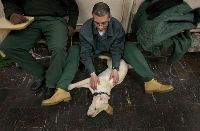
Aaron Ellis, 29, another Iraq veteran with the stress disorder, scrapped his medications entirely soon after getting a dog - and set foot in a grocery store for the first time in three years.
The dogs to whom they credit their improved health are not just pets. Rather, they are psychiatric service dogs specially trained to help traumatized veterans leave the battlefield behind as they reintegrate into society.
Because of stories like these, the federal government, not usually at the forefront of alternative medical treatments, is spending several million dollars to study whether scientific research supports anecdotal reports that the dogs might speed recovery from the psychological wounds of the wars in Iraq and Afghanistan.

They rely on their dogs to gauge the safety of their surroundings, allowing them to venture into public places without constantly scanning for snipers, hidden bombs and other dangers lurking in the minds of those with the disorder.
In August, Jacob Hyde got his service dog, Mya, from Puppies Behind Bars, a program based in New York state that uses inmates to raise and train dogs for lives of service. The organization has placed 23 dogs with veterans with PTSD in the past two years, training them to obey 87 commands.
"If I didn't have legs, I would have to crawl around," said Hyde, 25. "If I didn't have Mya, I wouldn't be able to leave the house."
If Hyde says "block," the dog will stand perpendicularly in front of him to keep other people at a distance. If he asks Mya to "get my back," the dog will sit facing backward by his side.
The dogs are trained to jolt a soldier from a flashback, dial 911 and even sense a panic attack before it starts. And, perhaps most important, the veterans' sense of responsibility, optimism and self-awareness is renewed by caring for the dogs.
The dogs help soldiers understand "what's happening as it's happening, what to do about it, and then doing it," said Joan Esnayra, a geneticist whose research team has received $300,000 from the Defense Department to study the issue. "You can use your dog kind of like a mirror to reflect back your emotional tenor."
The dog also often is the first visible manifestation of a former soldier's disability. Because people are curious about the animal, the veteran gets an opportunity to talk about his condition and his war experiences, which can contribute to recovery. More broadly, the dogs help increase public awareness of PTSD, which the Department of Veterans Affairs said affects about a quarter of Iraq and Afghanistan veterans with whom it has worked.
Under a bill written by Sen. Al Franken, D-Minn., veterans with PTSD will get service dogs as part of a pilot program run by the department. Training a psychiatric service dog and pairing it with a client costs more than $20,000. The government already helps provide dogs to soldiers who lost their sight or were severely wounded in combat, but had never considered placing dogs for emotional damage.
Source: The New York Times



Reader Comments
to our Newsletter